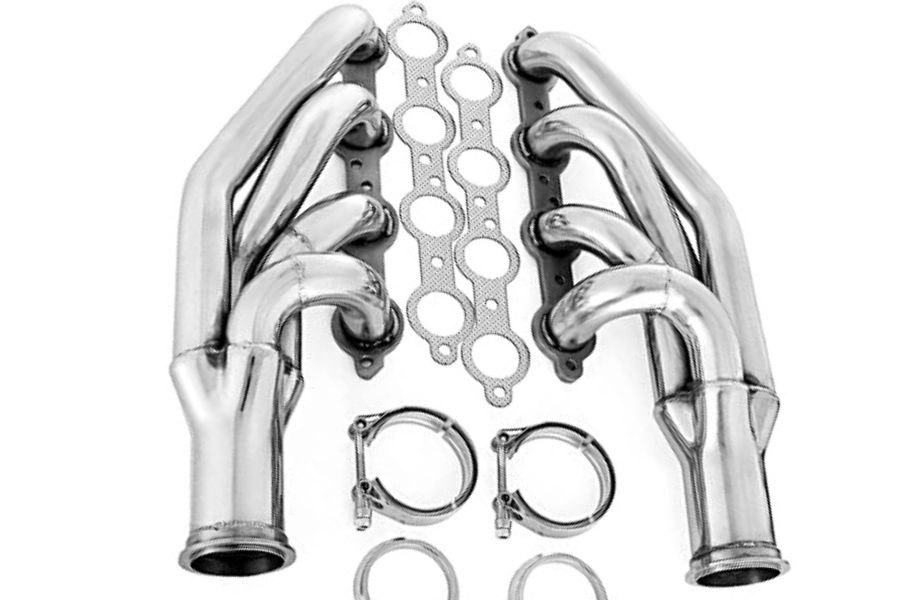Quick Navigation
When it comes to performance exhaust systems, choosing the right size header is essential for maximizing horsepower and torque.

In this article, we will compare 1 1/3, 1 5/8, and 1 7/8 inch headers for cars. These are some of the most popular sizes on the market.
These sizes are commonly used for performance exhaust systems, as they allow for increased exhaust flow. Also, improve horsepower and torque.
We will discuss their unique characteristics, benefits, and drawbacks to help you decide which size fits your vehicle best. Let’s get started!
Proper Header Tube Sizing
The common primary sizes for car header tubes are 1 ½”, 1 ⅝”, 1 ¾”, 1 ⅞”, 2″, 2 ⅛”, 2 1/4 “, and 2 ⅜”.
But the most popular tube header size in the market are 1 ¾”, 1 ⅝”, and 1 ⅞”.
When choosing the right size for your car header, there are several factors you have to consider, as follows:
- The size of your engine.
- The horsepower output.
- The average operating RPM.
- Usage of your car or type of racing (drag, road racing, circle track, tractor pulls, sprints, monster truck or hill truck, etc.)
- Or any power adders like nitrous or supercharger.
- Type of cylinder heads used.
- The bore and stroke application.
- The camshaft specifications (lobe centerline, exhaust opening, lobe lift)
- The car’s rocker arm ratio, exhaust valve, vehicle weight, gear ratio, and transmission type.
- What are the rest of the exhaust types? (piping size, muffler type, and how many?
It’s important to note that more data about your car will be more accurate in getting your header size.
The smaller type or short primary tube diameters will keep the air velocity up for more torque.
While the larger tube size will be a better fit for cars with an upper RPM above 6,500 RPM performance.
If the header is too small for your vehicle, it will cause restrictions and increase the engine’s heat.
On the other hand, when the header is too large, it will reduce torque output on the engine. It will cause an increase in exhaust gas reversion, increasing heat.
The torque is related to air velocity, the faster the air/fuel enters the engine, the more horsepower will volume up.
When air/fuel enters and exists on the engine quickly, the engine will make more torque.
When more volume of air/fuel passes through the engine, more horsepower will be produced by the engine.
Balancing both is necessary for streetcar applications, while racing-specific engines are usually designed with specific RPM ranges as requirements.
1 3/4 vs 1 5/8 vs 1 7/8 Headers – Comparison
The 1 3/4, 1 5/8, and 1 7/8 inch car headers are used in performance exhaust systems.
These headers will increase exhaust flow and improve horsepower and torque. Each size has unique characteristics and benefits, as well as potential drawbacks.
Here are the comparison highlights between the three:
1 ¾ inch Header Size
The 1 3/4 inch headers are bigger in diameter than the 1 5/8 and 1 7/8 inch sizes, which allows for more exhaust flow.
It can significantly increase horsepower and torque but also lead to more noise.
These headers are best suited for high-performance vehicles that require a lot of exhaust flow.
But may not be the best choice for daily drivers due to the increased noise.
Here are some keys to note when you choose 1 ¾ inch headers:
- If you have high-performance vehicles such as racing cars or heavily modified street cars application, 1 ¾ inch headers will suit your vehicle.
- Ensure your car is compatible with a large diameter header. Some vehicles may not have enough clearance to fit 1 ¾ inch properly with the existing exhaust system.
- Assess the overall performance goals of your car to see if a 1 ¾ inch header would be necessary for achieving those goals.
- A 1 ¾ inch header is not ideal for daily drivers due to the increased noise and may consume more fuel.
1 ⅝ inch Header Size

A 1 5/8 inch car header is a performance exhaust component that increases exhaust flow and improves horsepower and torque.
It is smaller in diameter compared to a 1 3/4 inch header but larger than a 1 7/8 inch header.
The 1 5⁄8 inch size has a good balance between performance and practicality.
It provides a moderate increase in exhaust flow while maintaining a relatively low noise level.
Here are some keys to note when you choose 1 ⅝ inch header:
- If you plan to enhance your vehicle’s performance without sacrificing practicality, a 1 ⅝ inch header is your best option.
- The 1 5/8 inch size is usable on many vehicles, such as daily drivers, performance vehicles, or even modified street cars.
- Ensure that your vehicle exhaust system has enough clearance to fit 1 ⅝ inch header. Also, ensure that this size can achieve the goal performance level of your vehicle.
1 ⅞ inch Header Size

A 1 7/8 inch car header is a performance exhaust component that increases exhaust flow and improves horsepower and torque.
It is the smallest in diameter compared to the 1 3/4 and 1 5/8 inch sizes. Allows for the least amount of exhaust flow, however, it also produces the least amount of noise.
Here are some keys to note when you choose 1 ⅞ inch header:
- If you plan to have a subtle performance boost on your vehicle that does not increase noise. But with a smaller diameter, a 1 ⅞ inch header will suit your needs.
- The 1 ⅞ inch size is also usable in many vehicles like daily drive cars, performance vehicles, and modified street cars.
- Ensure that 1 ⅞ inch will fit your current car exhaust system as it is smaller in diameter compared to other sizes.
The best choice of car header size will depend on your specific needs and preferences.
The 1 3/4 inch headers may be the best if you’re looking for maximum performance.
The 1 5/8 inch headers may be the best fit if you want a more balanced approach.
If you’re looking for a subtle performance boost without the increased noise, the 1 7/8 inch headers could be the right choice.
For Example:
To give you a better idea, here’s an example:
A common small block V8 engine that has 300-400 horsepower installed within a street rod.
Which spends most of its time operating on stop light to stop light, the 1 ½ inch header will be effective.
If you add a supercharger on the same engine, a 1 ⅝ inch to 1 ¾ inch header is a good fit.
If a racing car application has the same 400 horsepower that usually spends its time drag racing strip between 3,500 to 6,500 RPM.
A 1 ⅝ inch header is a bare minimum. At the same time, the standard recommended size would be 1 ¾ inch header.
Conclusion
The 1 3/4, 1 5/8, and 1 7/8 inch car headers are all popular choices for performance exhaust systems.
These sizes allow for increased exhaust flow and can improve horsepower and torque. However, each size has its unique characteristics, benefits, and potential drawbacks.
It is important to note that choosing the right size for your car’s header will vary depending on your needs and preference.
Also, consider the factors in getting the recommended size. We hope that the comparison we provide helps you choose the right header size for your car.

With comprehensive experience in writing exceptional quality articles and blogs about cars and related stuff, Daniel is one of the finest bloggers and a hardcore car lover we have. He is an ASE certified technician with an across-the-board experience of 10 years in the industry. He could not help tinkering with anything he got his hands on from a young age, which led to his remarkable career in the automotive repair industry.
When he is not under any hood, you can find him on the water or in the woods to pursue his passion for hunting and fishing. He has been writing for multiple sectors and is a regular contributor to several publications.
He currently owns a Nissan 300ZX TT and a Pearl Yellow but plans to upgrade it to 550 HP. His favorites include the Koenigsegg CCX and Lamborghini Diablo 6.0 VT, but for him, the Ferrari 360 Spider is one of the sexiest cars that exists to date.
Being an avid world traveler, he has spent most of his time analyzing the automotive markets, latest technology, and local favorites to enhance his knowledge base. He is currently living in North Caroline, where it’s all about food and coffee and, of course, cars.

